Vintage Recipe Roulette: 64 Vanilla Wafer Cake from 1975
This possibly unique version leads us to the drama-filled world of consumer packaging...and also some math. Yes, it will be on the test.
In case this is your first time visiting the Department of Antediluvian Disquietude and you missed the first installment, this is the latest in a series of Vintage Recipe Roulette reviews using only recipes from Talk About Good, my grandmother’s 1975 community church cookbook. In just 164 pages, this collection of homestyle recipes encapsulates the unlikely intersections of 1800s frontier cuisine, post-war convenience foods, and the mid-century American fetishization of canned chow mein noodles. It is untested, unstandardized, and unmatched in its vintage glory in my opinion. Some of the recipes are amazingly good! And some are amazingly…not. Today, we make a…well, I’m not sure what it is. Let’s find out.
When I get older, losing my hair, many years from now, will you still need me, will you still feed me, when I’m elbow-deep in 64 vanilla wafers to make a confection of uncertain character? I certainly hope so.
I’ve never made this…thing…but I’ve always wanted to, just because of the name. It’s quite an odd recipe even for the time. There are lots of “cake” recipes using cookies instead of flour, but they are usually “icebox” cakes (like this one from the 1930s) — whole or crushed cookies are layered with things like whipped topping and fruit, and left to languish in the fridge overnight, so that the whole thing melds into a slice-able conglomeration. Imagine what a delight that just have been, when refrigeration was new! No need to turn on the oven in the summer, nor even to mix a bunch of ingredients since the cookies could now be purchased packaged! (This is foreshadowing.)
This recipe from my grandmother’s cookbook, though, is different — the crumbs are mixed with egg, coconut, and nuts, and baked again, sort of like dessert twice-baked potatoes.
I’ve dug around a bit but can’t find the origin, other than that it appears to be from the Southern United States, and the other versions I can find call for the whole box of vanilla wafers. I can’t find one that instructs to count out 64 cookies anywhere else. Chances are, the overall recipe is from Nabisco’s Nilla Wafers, since recipes from brands of the mid 1900s were so popular, but maybe the 64 wafer cake is a modification to let the thrifty home cook use up the remains of a box of stale cookies? At the time, they were packaged in a waxed paper bag inside a paperboard box — not the most effective freshness device ever, but a real triumph of its time, and the story of how it came about is pretty interesting. Although mulberry bark paper as a food wrapping is about 2,000 years old, paperboard has only been used as food packaging since the late 1800s, when a mishap at a printshop resulted in paper labels being cut by the printing die, and the shop owner envisioned a one-step, thin and foldable carton. The food carton industry has hummed along basically unchanged since then, except for the cereal slot closure controversy…but the creator of the waxed bag-o-freshness inside the cartons? That was none other than our old friend, the National Biscuit Company. (Nabisco, get it?) Before they were the Wafer King, they made a kind of hardtack thing for sailors, a national biscuit, if you will, dating back to the 1700s. So there you have it, crackers are older than cracker boxes.
Today, we’re making this cake…thing. Here are the ingredients!
Oleo was a kind of margarine, so if you’re using butter instead, make it salted. “Sweet milk” is what we think of as regular milk, as opposed to buttermilk. And no, I am not using Nabisco wafers, because they are twice the price for just 1 oz. more cookie, but a lot more fructose. One of my main questions is, what percentage of a whole box is 64 wafers? Sure, I could count them out, but it’s a lot easier to use a kitchen scale! You could weigh one and multiply by 64, but to reduce error, it’s better to weigh 10 and divide by 10 to get the average weight of one, and then multiply by 64. In this case, the average weight of one wafer is 4.6 grams, so 64 should weigh about 294 grams. The box contains 284 grams, so…uh oh! But the Nabisco box has 311 grams, and that would be too many cookies, roughly 3 extra.
What gives with the counting? Well, Nabisco wasn’t the only purveyor of the vanilla-flavored wafer cookie in days of yore; Virginia’s Southern Baking Company had them in 13 oz. tins. This is a southern recipe, so maybe it used those. To complicate matters, the 1970s Nabisco vanilla wafer box had 12 oz. in it! (And yes, they used to be called Vanilla Wafers. It was abbreviated to Nilla in the 1960s.)
Does that mean this recipe left you with a few for snacking? Did they all and always weigh an average of 4.6 grams, or was each individual cookie bigger once upon a time? Your guess is as good as mine. The only way we’ll find out is by seeing whether or not my guesswork yields something edible.
Let’s double check our math, since we hit a little hiccup! We’ll need to use the whole box, and it looks like that’s 63 cookies!
Maybe this will work out. We’ll take a look at the batter when it’s mixed, and revisit whether we need more crumbs.
I’ve decided to crush these up manually, because if I run them through the food processor, the crumbs will be very, very fine, and I’m concerned a little bit of remaining texture might be necessary to avoid a pasty cake.
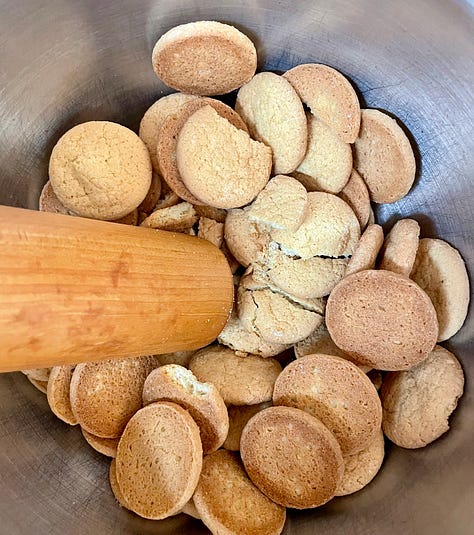
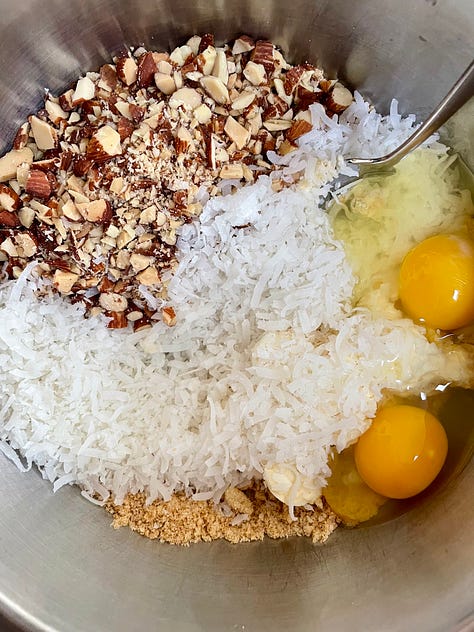
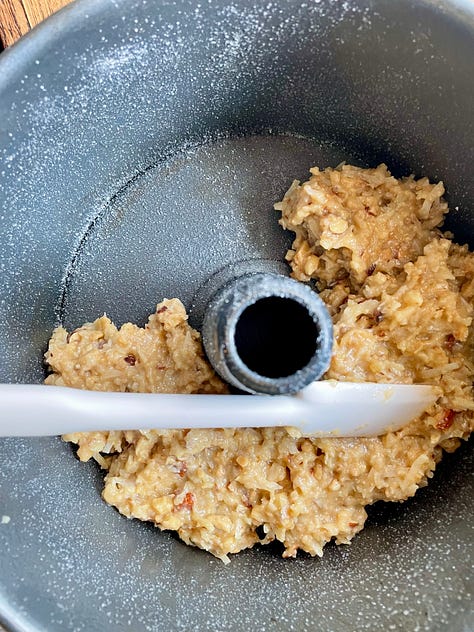
Usually, cake recipes start by telling you to cream the fats with the sugars, but there’s nothing like that here. Is that because it’s an old recipe, or because the flour is already technically baked, and you don’t need to coat it with the margarine? (If you want to read more about the “cake method” and its kin, I had a relevant piece out for TODAY just last week, about those viral Olympic Village chocolate muffins — and I used a lot of math in that one, too, to make 1/3 of each of 3 recipes so that I didn’t have 27 delicious chocolate muffins to eat three meals a day for a week, plus snacks.)
I’m going to throw caution to the wind and just mix all of this —the marge is soft, and with a fork, it works just fine. Another question was what kind of pan I should use, since the instructions don’t say. Most of the other related recipes use a Bundt pan, and they say it takes an hour to bake! The batter’s almost cookie dough-like ingredient ratios mean it is pretty sticky, so I oiled and sugared the pan even though it’s nonstick, and of my 2 Bundt pans, I chose the one with fewer nooks and crannies.
It did indeed take an hour, much to my surprise, but it looks pretty good! The top is kind of crackly and the edges are crunchy sugar. I had to take my time getting it out of there, though — it definitely stuck. Let’s give our 63 Vanilla Wafer Cake a taste.
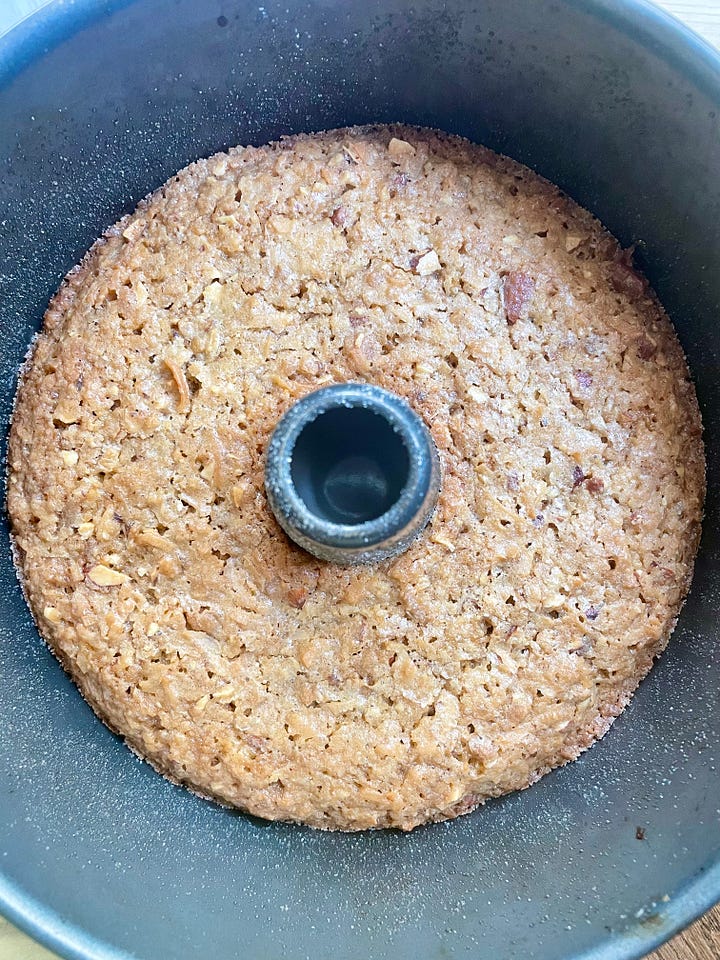
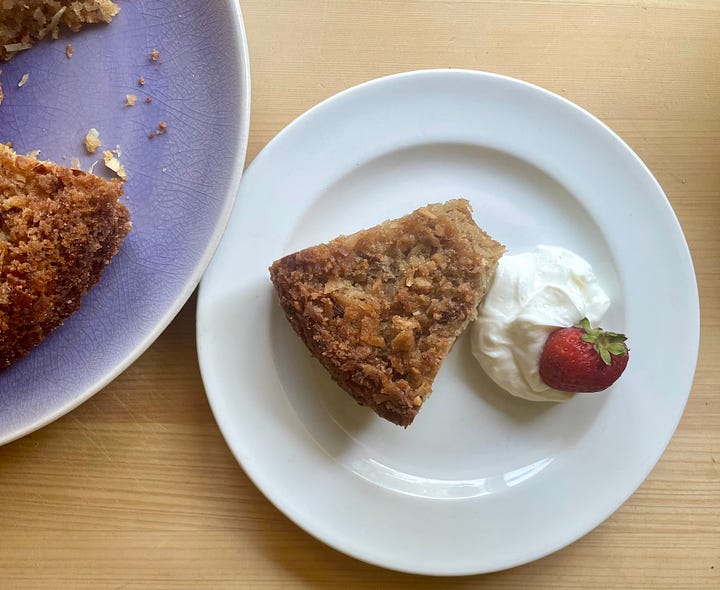
Welp, it is more like a cookie bar than a cake in modern terms. It’s very sweet, and very heavy, but it’s not pasty, and despite the very short ingredient list, it has a lot of flavor. It reminds me of those magic cookie bars, without the chocolate and gooey condensed milk. Although you’d never know this is made out of cookies, their vanilla, plus the coconut and nuts and all that margarine, give this cake a beautiful buttered toast quality, assuming you spread your toast with Almond Joys. I like it! But man, a little goes a long way. If you make this, I might suggest baking it in a parchment-lined 11x7 pan for less time, or it in a muffin tin with paper liners for a lot less time, and then freezing them so you can have one here and there at your leisure.
Until then, study up! I know you want to do well on the quiz next week.
Zen and the Science of Candy Corn is a reader-supported publication that brings me great joy. You can literally give me your 2 cents with the tip jar button below!
But if you decided to subscribe, free or paid? That would be cracking!
And please feel free to share this post with any Almond Joy toast psychopaths devotees you know.







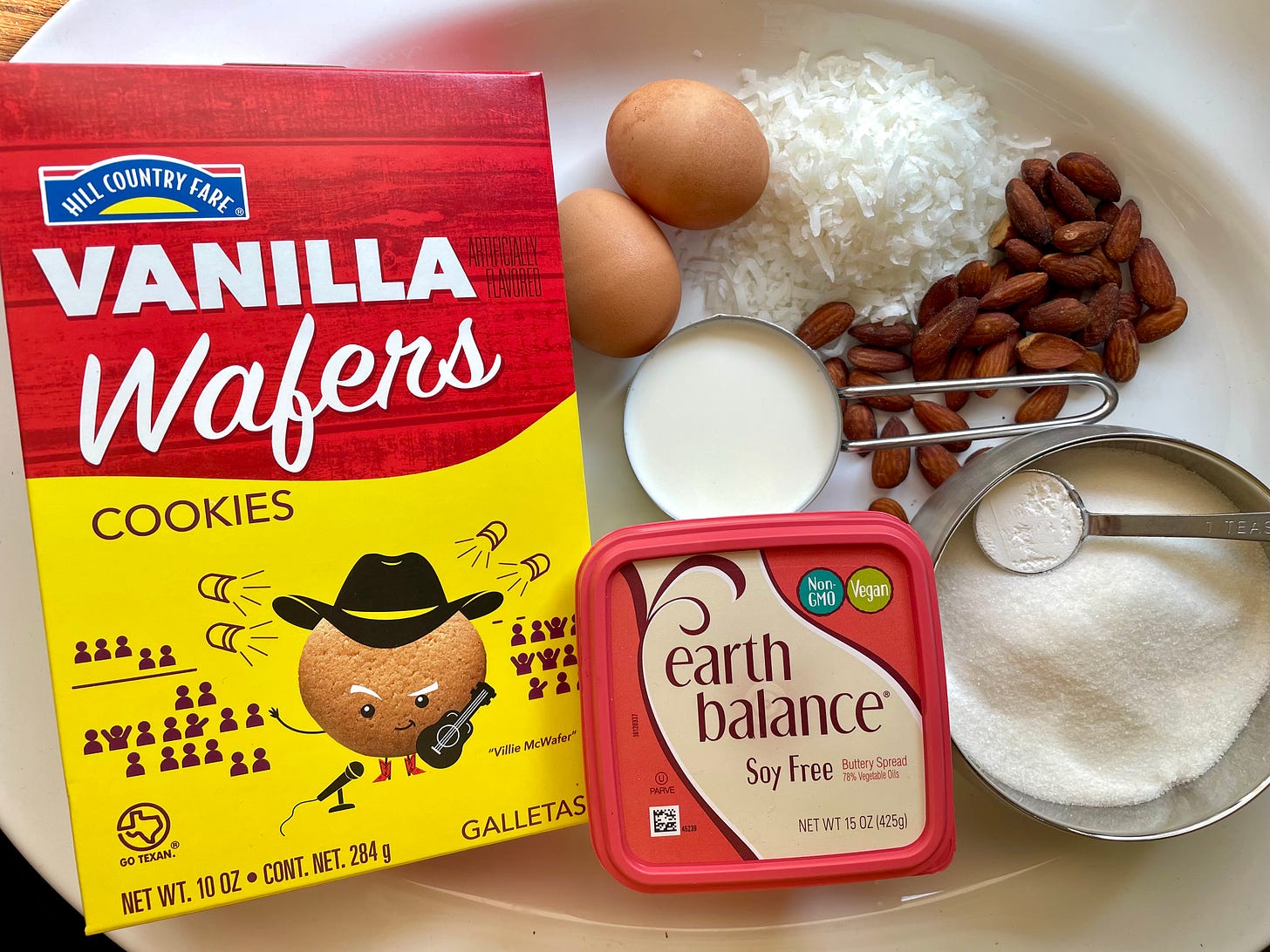
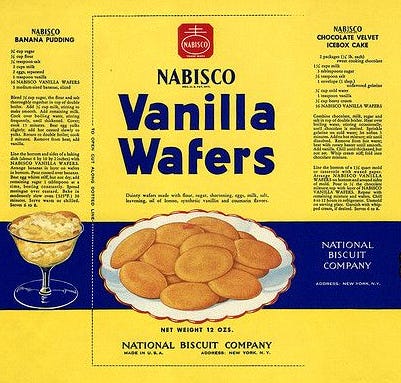
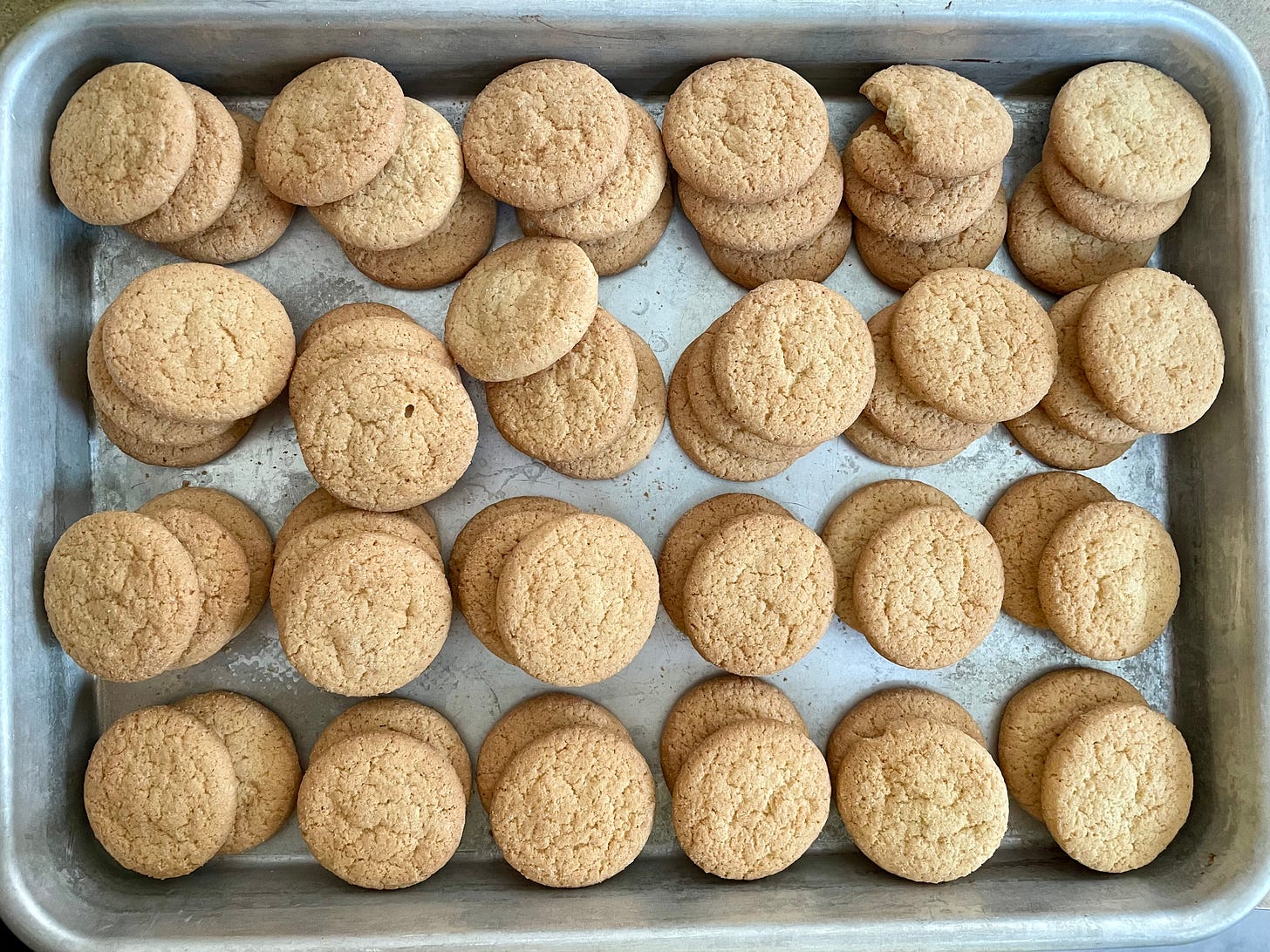
This use of cookies (crumbs) to make cake - the (as you said) twice baked potato of cakes - has a long and proud history. Naples biscuits were the pre-cooked cookies of the 18thC. And the original Gingerbread was reused/reconstituted breadcrumbs!
Honestly - you’ve opened a new door in my quest for “modern versions of old food/techniques”
Woo!